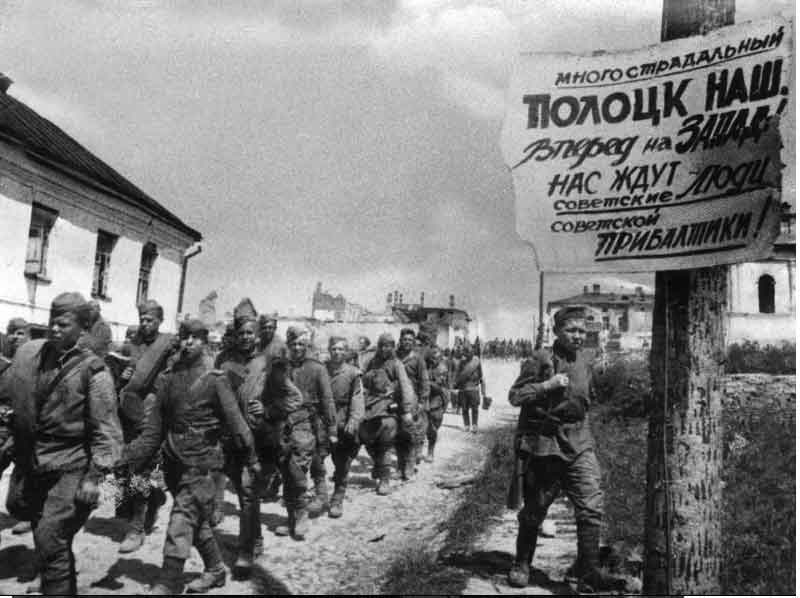July 1944
Russians REach the Polish Border

Soviet troops in Poltsk
To coincide with D-Day the Russians launched a multi pronged offensive in the East. The attacks were all successful and the Soviet army was able to advance into Eastern Poland.
By the beginning of 1944 the Russians Soviets were beginning to achieve the upper hand all along the front, they had more men, more tanks, more aircraft. The time was ripe for a major offensive, an offensive that Stalin had promised the Americans and the British would take place soon after D-Day to make sure that the German could not reinforce their troops in France with troops from the Eastern Front. The Soviet goal was to keep the German guessing, not allowing them to reinforce any of their positions with enough troops to stop the Soviets. The Soviets with more men available were able to keep the German guessing until it was too late. The name of the overall operation was called Operation Bagration
On June 23 the Soviets launched the first stage of their offensive known as the Vitebsk-Orsha offensive in Beloruss. The Soviets achieved all of their objectives capturing the cities Vitebsk and Orsha and killing over 41,000 German soldiers and taking another 17,000 prisoner.
The second stage of the offensive was the Mogilev Offensive whose goal was the capture of the key city of Mogilev. The second goal of the offensive was to pin down the German Fourth Army it too began on June 23rd with a large artillery bombardment. The Soviets broke through
strong resistance and captured Mogilev . 33,000 German soldiers were killed and an additional 3,250 were captured
The third part of the offensive was called the Bobruysk Offensive, it was aimed at capturing Bobrusyk by breaking through German 9th army. The Soviets launched a twin offensive that succeeded in capturing Bobrusyk. 12,000 German soldiers managed to escape but over 20,000 were captured and over 50,000 were killed in the fighting.
The second stage of the offensive began on June 28th with the goal of capture Minsk it was called the Minsk Offensive. Soviet troops crossed the Berezina. The Soviets attack Minsk from the North and the South, enveloping it and trapping the Fourth Army and what was rest of the Ninth army. Minsk was liberated on July 4th. Over a period of a few days the German lost 25 division with 300,000 men. The German Group Centre effectively ceased to exist.
The Soviets then went on to capture Poltsk, blocking a possible counter offensive by the German Northern Army group.
At this point the extent of the German defeat became clear, and although the objective of the offensive had been reached Minsk, the decision as made to exploit the success and begin offensive operations along the Baltic. The Soviets in the North moved toward Riga, while in the center the troops who had captured Minsk moved on the Vilnius. The Soviets captured the city in what became known as the Battle of Vilnius on July 13.
The Soviets then launched the Belostock Offensive which capture the Polish town of Bialystok after two days of fighting on July 23rd.
The final stage of the offensive took place between July 18th and August 2nd as Soviet troops crossed deep into Poland. They crossed the Bug River on July 21st and captured Lublin. They went on to the Vistula River which they reached by August 2nd effectively ending the offensive.
Operation Bagration was the biggest defeat of the Germany army during World War II. It pushed the German out of the Soviet Union, resulted in the death of close to 400,000 German soldiers with an additional 158,000 captured.
 >
>